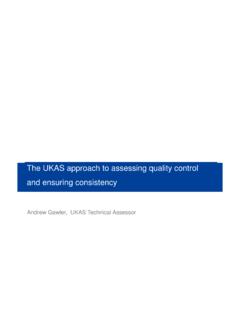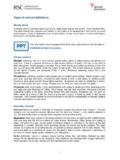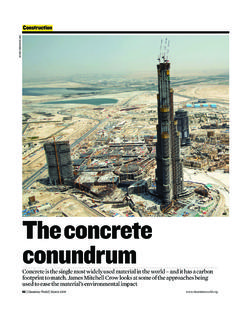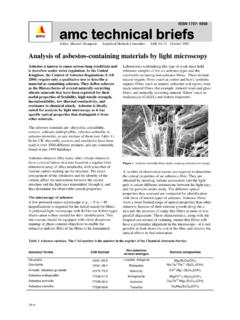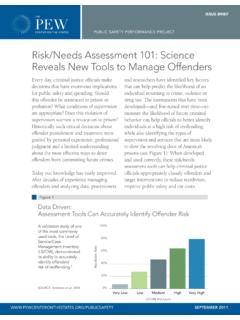Transcription of Fractionating Hydrocarbons For Hazard and Risk …
1 Fractionating Hydrocarbons For Hazard and Risk assessment ; chemical and biological AnalysisRisk assessmentRisk assessmentWhy do this? Risk managementis thelanguage of business andregulation Showing we can manage risk instilsconfidence Confidence builds trust in stakeholders Trust supports legitimacyand community buy-ininto regeneration a critical quality of life endpoint for sustainable communitiesrisk instilsconfidence B oil extracted from a oil-contaminated clay soil prior to remediation. A residual oil remaining after windrow C oil extracted from heavily contaminated peaty soil from a decommissioned oil analysisChemical analysisExtractionClean-up/class fractionationanalysisRisk to human health and environment from weathered petroleum hydrocarbonsRespirationMPNB iosensorBiological analysisIndicators compounds and fractionsEcotoxicological testshydrocarbonsBiosensorsSeed germinationEarthwormsRespirationHuman and environmental toxicologyHuman exposure modelsWater environment modelsSECOND LINK BIOREMEDIATION PROGRAMMEBIOREM 35 Optimising biopile processes for weathered Hydrocarbons within a risk management framework - PROMISES.
2 Pollard, F. Coulon, G. Paton, J. Bellarby, K. Semple, G. Risdon, B. Bone, K. Brassington and S. analysisChemical analysisSpeciation of oil extract (class fractioning)Identification of oil target compoundsChemical analysis Develop a robust analytical procedure for diagnostic tool kit Complete recovery (low bias) Good precision (within and between batch) Conform to Environment Agency mCERT sperformance targets (30% bias, 15% precision) Compatible with UK risk framework (Carbon banding Compatible with UK risk framework (Carbon banding convention(s) and Class fractionation) Outputs: Move to ultrasonic sequential solvent extraction with Acetone and hexane Generate high throughput and fast process. scalable Remove evaporative steps Solvent exchange via water partitioning prior to class fractionationContaminated Land Exposure assessment : CLEA modelTDIoral (g kg-1 bw day-1) TDII nhalation (g kg-1 bw day-1) hydrocarbon fractions EA (2006) MADEP (2002) TPHCWG (1997) EA (2006) MADEP (2002) TPHCWG (1997))
3 Target organs/systems or effects Aliphatic fractions >C5-C6 60 40 5000 200 60 5250 >C6-C8 2000 40 5000 770 60 5250 Neurological >C8-C10 100 100 100 60 60 285 >C10-C12 100 100 100 60 60 285 >C12-C16 100 100 100 60 60 285 Liver, blood >C16-C35 2000 2000 2000 - - - Liver >C35-C44 6000 - 20000 - - - Tolerable daily intake>C35-C44 6000 - 20000 - - - Aromatic fractions >C5-C7 - - 2 - - 9 >C7-C8 200 - 200 74 - 115 Liver, neurological >C8-C10 100 30 40 63 15 60 >C10-C12 40 30 40 15 15 60 >C12-C16 40 30 40 15 15 60 Body weight >C16-C21 30 30 30 NA 15 - >C21-C35 30 30 NA - - Kidney >C35-C44 - 30 NA - Combined Aliphatic and aromatic fractions >C44-C70 30 NA - Typical targets values in petroleum hydrocarbon -contaminated soilsPetroleum hydrocarbon fractions GACa (mg kg-1) UK SSACb (mg kg-1) UK Targets organs/ systems or effects Residential without plant uptake Industrial/ commercial Residential without plant uptake Industrial Aliphatic >C5-C6 397 Neurological >C6-C8 242 69000 >C8-C10 11300 Aliphatic fractions Liver, blood >C10-C12 29900 15700 >C12-C16 29900 4888 16800 >C16-C35 27600 617000 137957 Liver >C35-C44 27600 617000 414509 Aromatic fractions >C5-C7 84 Liver, neurological >C7-C8 186 >C8-C10 107 250 Body weight >C10-C12 625 45021 >C12-C16 12200 148 60650 >C16-C21 291 9190 1825 46430 Kidney >C21-C35 417 9250 2074 46553 >C35-C44 417 9250 2074 46553 >C44-C70 417 9250 2073 46553 fate drives analysis , exposure and performance log Koil-soilcoefficients weathering increasesPAH log Koil-soil risk = f (availability and toxic response)Fugacity approach.
4 Level I and IIFugacityfSorbed on mineral soilCOil (NAPL)CNAPLAir (pore space)CAGACAGACBAZO=KOW/HZA=1/RTtoxic response) Combination of advective processes and degrading reactions Determination of compounds persistence or residence timefCsPore waterCwCNAPLZS=Kp s/HZA=1/HGWCBWGWCWG eneral partitioning behaviour and preferential partitioning in a constructed biopilePartitioning behaviour: Fugacity level IAirWaterSoilNAPL1 > EC10-EC12 (a) (a) (ghi) > EC12-EC16> EC16-EC21> EC21-EC35 Fugacity calculator for subsurface environments. Available time: Fugacity level IIDistribution of 5 chemicals modelled in soil microcosms where advection and degradation reaction were combined100 mol of each compound was used in the modelEnvironmental Standards and DWS valuesCOC EQS/DWS ( g/l) Phenols Monohydric 30 Benzene 10 Toluene 10 Ethyl benzene 10 m & p Xylene 10 o Xylene 10 Aliphatics C5-C6 10 Aliphatics >C6-C8 10 Aliphatics >C8-C10 10 Aliphatics >C10-C12 10 Aliphatics >C12-C16 10 Aliphatics >C16-C21 10 Source pathwaypathwayreceptorsgroundwaterAlipha tics >C16-C21 10 Aliphatics >C21-C35 10 Aromatics C6-C7 10 Aromatics >C7-C8 10 Aromatics >EC8-EC10 10 Aromatics >EC10-EC12 10 Aromatics >EC12-EC16 10 Aromatics >EC16-EC21 10 Aromatics >EC21-EC35 10 Naphthalene 10 Benzo(b)fluoranthene Benzo(k)fluoranthene Benzo(a)pyrene Indeno(123cd)pyrene Benzo(ghi)
5 Perylene BioassaysEarthwormsPlantsMicrobialEiseni a fetidaLumbricus terrestrisLethal and Sub-lethalMustardPeaRye grassSeed GerminationBiomassRespiration Enzyme assayslux-based bacteriaNitrification The Hydrocarbons will age and the bioavailability (as a function of degradation and toxicity) will change Toxicity may increase and What do we expect to happen?60708090100 Bioavailable / Loss% Bioavailable% Non-bioavailableDecreasingBioavailable Ageing Toxicity may increase and then decrease in association with biodegradation Field scale validation may respond in parallel0 Arbitrary Time1020304050% Bioavailable / Non-Bioavailable / LossBioavailable Fraction withtimeIncreasingNon-Bioavailable Fraction withtimeSoil B 160002000024000 TPH Concentration mg/kgRiskHresidential Eco Water 04000800012000024681012141618 Tim e (Months )TPH Concentration mg/kgCONTROLN/PINNOCULUM N/PPromisePromisePromiseSoil C 160002000024000 TPH Concentration mg/kgCONTROLN/PINOCULUM N/P04000800012000024681012141618 Tim e (Months)TPH Concentration mg/kgRiskHresidential Eco Water PromisePromisePromisePre-mixingInoculumW indrow TurningWindrow TurningImportance of IrrigationRoutine Monitoring ContinuesTPH Degradation- Biopiles200025003000 TPH Concentration (mg/kg)
6 Control (Biopile + no enhanc)*RiskHresidential Eco Water 05001000150003791 DayTPH Concentration (mg/kg) (Biopile + no enhanc)(Biopile + Nutrient)(Biopile + Nutrient +Inoc.)**PromisePromisePromiseTPH Degradation- Windrows1500200025003000 TPH Concentration (mg/kg)Control Windrow controlNutrientNutrient + Eco Water 050010000102030405060708090 DayTPH Concentration (mg/kg)PromisePromisePromiseRemediation Decision Support Tool Developed support tool based on 3 tiers, designed to reduce uncertainty in technology selection Road tested on genuine scenarios Road tested on genuine scenarios The tool assists in the decision making process of remediation technologies: Enabling transparent justification of selection Gives focussed and streamlined support for targeting best options. Interfaces with web to enable continual updating as practices become established and lessons are learned Empirical data from thirty sites have been generated & applied to appraise and validate.
7 Resp [TPH] BF = bioremediation functionI = induction[TPH] =TPH concentrationPredicting hydrocarbon Remediation? (I x [TPH] [TPH] log (MPN) BF = x x Inhibition [TPH] =TPH concentrationMPN = most probable numberResp = respirationBF & Rate of DegradationRate (mg/kg/day)100100010000BF1e+11e+21e+31e+ 41e+51e+61e+71e+8 Rate (mg/kg/day)110100 hydrocarbon ValidationOVERVIEW-ORGANISING A SUITABLE MATRIXTier 1 Cost estimator for the remediation of the contaminated site and generic optionsPhase 1 Desk-based assessment of site characteristics and estimation of potential harmPhase 2 Intrusive investigation of the site and quantitative risk assessmentTier 2 Phase 3 Diagnostics of most suitable strategy for remediationPhase 4 Verification of the remediation strategyTier 2 Detailed options appraisal-allowing comparative and transparent approachTier 3 Detailed options appraisal-allowing comparative and transparent approachTIER 1-RAPID OVERVIEW WITH LIMITED DATAP robability/ Consequence MatrixConsequenceSevereMediumMildMinorV. )
8 Likely V High Risk High Risk Moderate RiskModerate/ low riskProbabilityRisklow riskLikelyHigh RiskModerate RiskModerate/ Low RiskLow riskLow LikelyModerate Risk Moderate/Low riskLow Risk Very low riskUnlikely Moderate/ LowRiskLow risk Very low riskVery low riskData Input from Phase 1 Data Input from Tier 1 OutputTIER 2-SITE SPECIFIC MATCHING OF TECHNIQUESWhat is the size of the site?-user defined input hectaresHow many contaminant source zones are there? User definedWhat are the chemicals of concern at each of the contaminant source zonese? What is their likely risk?What media require to be remediated?Soil1. Metals and Semi-metal 2. Total Petroleum Hydrocarbons3. PCBsLandfill1, 2, 3, 4,5,6,7,8 Tier 1 deals with source removal/ containment and impacted groundwater. Is source remediation the practical solution?YesNoIndividually define the area of each of the contaminant source zones.
9 User defined4 . CyanideGas SoilTreat Water6. AsbestosMethods using excavationMethods not using excavationChemical/ PhysicalBio-on site ex situ1,2,3,4,5,72, 5 chemical / PhysicalCappingBio-on site in situ1, 2, 3, 4,5,71, 2, 3, 4, 72, 5 PassiveActivePump and TreatNon Pump and Treat1, 2, 4,5,71, 2, 4,5,74 . Cyanide5. Chlorinated solvents7. Pathogens8. GasWill source removal mitigate the water environment?YesNoDo I still require action for gas mitigation?Do I still require action for gas mitigation?NoYesEndGas MitigationWhich does what?Chemicals of ConcernRemediation DST Tier 2 Site nameContaminated materialCompleted byDate completedWhat COCs require remediation?Is the COC present as a NAPL in the matrix/ groundwater?Is the matrix capable of supporting high bioactivity?Do any of the COCs have a high Kd or Koc in the matrix?What is the texture of the matrix?Does the matrix have high hydraulic conductivity?
10 Is the contaminated groundwater in a confined aquifer?Is there a hydrologically-impermeable layer to make the placement of a barrier a SOILGROUNDWAT ER Visual basic interface Multi-pollutant credible Considers major processes Links to a ranked outputlayer to make the placement of a barrier a viable option?Is there likely to be such strong flow of relatively clean groundwater that Pump-and-Treat is not a viable option?Is excavation of the contaminated matrix a viable option?Is there space on site for ex situ treatment of the contaminated matrix?Can the storage and treatment of excavated material be conducted without impairment of the surrounding environment?Is the availability of water a potential constraint on remediation?For how long can site use or redevelopment be constrained by remediation activities?How long until remedial targets must be achieved?Does COC removal have to be achieved?Tier 1 Cost estimator for the remediation of the contaminated site and generic optionsPhase 1 Desk-based assessment of site characteristics and estimation of potential harmPhase 2 Intrusive investigation of the site and quantitative risk assessmentTier 2 Tier 2-Relative RankingTransparent comparison between technologies- relative tankingPhase 3 Diagnostics of most suitable strategy for remediationPhase 4 Verification of the remediation strategyTier 2 Detailed options appraisal-allowing comparative and transparent approachTier 2-CostA detailed cost comparison of the most suitable techniquesTier 2-EnvironmentRelative carbon costing of the defined technologiesTier 3 Detailed options appraisal-allowing comparative and transparent approachTIER 3-SITE SPECIFIC PROCEDURES WITH REGULATORY ENGAGEMENTT echniques for SoilPassive TechnologiesTechniques that remove contaminantsTechniques that immobilise

